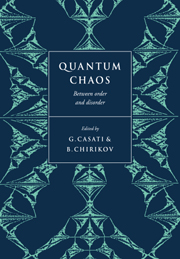Book contents
- Frontmatter
- Contents
- Preface
- Acknowledgments
- Introduction
- Part One Classical chaos and quantum localization
- Part Two Atoms in strong fields
- Part Three Semiclassical approximations
- Semiclassical theory of spectral rigidity
- Semiclassical structure of trace formulas
- ħ-Expansion for quantum trace formulas
- Pinball scattering
- Logarithm breaking time in quantum chaos
- Semiclassical propagation: how long can it last?
- The quantized Baker's transformation
- Classical structures in the quantized baker transformation
- Quantum nodal points as fingerprints of classical chaos
- Chaology of action billiards
- Part Four Level statistics and random matrix theory
- Index
Pinball scattering
Published online by Cambridge University Press: 07 May 2010
- Frontmatter
- Contents
- Preface
- Acknowledgments
- Introduction
- Part One Classical chaos and quantum localization
- Part Two Atoms in strong fields
- Part Three Semiclassical approximations
- Semiclassical theory of spectral rigidity
- Semiclassical structure of trace formulas
- ħ-Expansion for quantum trace formulas
- Pinball scattering
- Logarithm breaking time in quantum chaos
- Semiclassical propagation: how long can it last?
- The quantized Baker's transformation
- Classical structures in the quantized baker transformation
- Quantum nodal points as fingerprints of classical chaos
- Chaology of action billiards
- Part Four Level statistics and random matrix theory
- Index
Summary
Abstract
Classical and semiclassical periodic orbit expansions are applied to the dynamics of a point particle scattering elastically off several disks in a plane. Fredholm determinants, zeta functions, and convergence of their cycle expansions are tested and applied to evaluation of classical escape rates and quantum resonances. The results demonstrate the applicability of the Ruelle and Gutzwiller type periodic orbit expressions for chaotic systems.
Introduction
At the heart of semiclassical descriptions of chaotic systems is the Gutzwiller trace formula which relates the eigenvalue spectrum of the Schrödinger operator to the periodic orbits of the underlying classical system [1]. This relationship between the classical and the quantum properties can be viewed as a generalization of the Selberg trace formula which relates the spectrum of the Laplace-Beltrami operator to geodesic motion on surfaces of constant negative curvature [2]. Whereas the Selberg trace is exact, the Gutzwiller trace, derived within a stationary phase approximation, is only approximate, valid in a suitable semiclassical limit.
In one-dimensional systems the trace formula recovers the standard WKB quantization rules, which yield easy and sometimes quite accurate estimates for the quantum eigenvalues [3]. For systems with more than one degree of freedom a classical system can exhibit chaos. The simple WKB quantization fails and evaluation of the trace formulas can become rather difficult; in fact, it is often easier to do the full quantum calculation and to obtain the periods of classical periodic orbits from the quantum data by a Fourier transform [4].
- Type
- Chapter
- Information
- Quantum ChaosBetween Order and Disorder, pp. 405 - 434Publisher: Cambridge University PressPrint publication year: 1995

